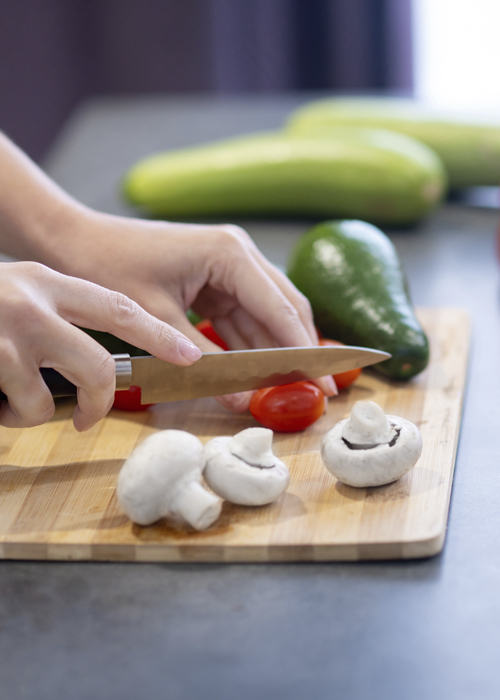Fry lightly:
Fry various ingredients (generally used as a base for a stew, sauce, etc.) for a short period of time to homogenize their taste.
Batter:
The preliminary step some foods go through prior to frying. It consists of coating ingredients with flour and beaten egg. The purpose is to create a layer to help food retain its juiciness. Orly or Tempura dough can also be used for coating.
Breading:
Same technique as batter, with a final coating of breadcrumbs. We create a thicker crust than the layer obtained with battering.
Egg mollet:
Consist of boiling an egg for 3 to 5 minutes. This way the white part of the egg will be set while the yolk remains runny. The difference between a boiling time of 3 to 5 min will determine the texture of the egg. Softened butter. Working into butter to soften it without letting it reach a temperature above 60ºF. It can be kneaded using your hands or beaten once we have it at room temperature.
Tempura:
Mixture of flour and water used to batter foods. At the stores we can find tempura flour that only requires to be mixed with ice water. If we want to prepare it home, we will use either a very fine type of flour or rice flour. It is important the water is cold.
Orly:
Type of dough used to batter foods to protect them when frying. Regular composition of Orly is flour, water, yeast, salt and egg. Yeast can be substituted for beer or soda providing volume and softness to ingredients when fried
Sobao:
Sponge cake. A popular dish from the Pasiegan valleys in Cantabria (Spain) made of flour, butter and eggs.
Muscovado sugar:
Unrefined cane sugar, dark brown in color, viscous texture and wet appearance due to the molasses it contains. Intense flavor of licorice, caramel and butter.
Truss:
Trussing a chicken (or any other bird) or a meat cut to help maintain its shape or keep its filling in place during cooking.
Skewer:
A long metal or wooden pin used to pierce and secure small pieces of food during grilling.
Clarify:
Technique used to remove impurities broths, gelatin, butter or juices.
Reduce:
To boil a broth, sauce or any other liquid and thicken through evaporation.
Coulis:
A form of thick sauce made from puréed and strained vegetables or fruits.
Cover:
Pouring a sauce or juice over food until completely covered.
Brown:
To cook food until it takes on a golden brown color.
Grease:
To apply a thin layer of butter or oil on food or utensils to prevent foods from sticking to them during cooking.
Sprinkle:
Covering food partially by scattering a powdered or grated ingredient.
Scald:
Cooking briefly in boiling water, to soften ingredients and ease their peeling.
Skim:
Remove impurities and foam off a broth or sauce.
Fumet:
Fish stock often boiled down to concentrate the flavor, and used as a base for other recipes.
Meat or Poultry Fumet:
Meat or poultry stock often boiled down to concentrate the flavor, and used as a base for other recipes.
Baste:
Coating an elaboration with its own juices during roasting in the oven to polish the surface.
Au gratin:
Place food under the grill or a salamander to brown the surface.
Marinate:
Cover food with a liquid, sauce, liqueur or an herb dressing for a few hours to tenderize and flavor.
Macerate:
Soaking food in a cold liquid to add flavor.
“Wet”:
Pour water, broth, sauce, wine, or any other liquid onto food.
Al dente:
Correct degree of doneness when cooking pasta and vegetables.


